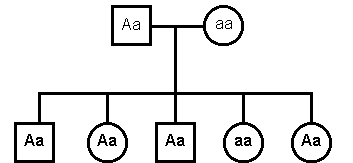
In this simulation, each team will be provided with a pedigree chart. The team will also be given the kind of genetic disorder that will be illustrated by the pedigree. One chart will be used to develop the genotype of the pedigree. The exercise involves filling out the genotype pedigree chart by tossing a coin to determine the genotype of the offspring. Depending upon the genetics of the trait, the phenotype pedigree charts will be filled in.
First note the genotype for select individuals on the genotype chart, see example below. In the following example, the father is heterozygous and mother is homozygous recessive.

To produce offspring:
(1) Decide which
copy of the gene correspond to heads and tails, for example,
heads = A
and tails = a. Once decided, keep it the same throughout this exercise
(2) Select the
genotype of the offspring that will determine the genotype. [i.e. the
individuals
showing the trait]
(3) Toss a coin
once for the father. This determines which copy of the gene the
father contributes
to his offspring. You need not toss a coin for any homozygous
parent.
In the example given here, you need not toss the coin for the mother
since she
can only contribute a.
(4) Continue
for each blank individual on the genotype pedigree chart. Faithfully
note
the result
of each coin toss. Even if the expected ratio of offspring genotypes
is
1Aa : 1 aa,
as in this example, if each time you toss the coins you came up with
Aa, do not
fudge the data but write Aa for each offspring. By tossing a coin
we
are simulating
nature; each offspring is a result of random choice of one of the two
copies of
the gene in each parent.
(5) As you determine
the genotype, or after completing the genotype pedigree chart,
fill in the
phenotype pedigree charts appropriate for the trait that you are
assigned.
For example, let's say that we got the following genotypes:

If the trait you were assigned was dominant, your phenotype chart would look like:

On the other hand, if your trait was recessive your phenotype chart would look like:

Mark all phenotype charts in the same way. Be sure to have a phenotype chart for your group and one of the other groups in the class, plus one for the instructor [three phenotype charts and one genotype chart].
When you are finished, keep the genotype chart and a copy of the phenotype chart and distribute a phenotype chart to your neighbor group and to the instructor. You will get phenotype charts from your neighbor group.
First, look at your own phenotype chart and discuss within your group whether one can unambiguously decide whether the trait was a dominant, recessive or sex-linked recessive trait from the information in the phenotype chart. If the trait can be something else than that assigned to you, write the alternative genotypes which would be consistent with the alternative.
Second, study the phenotype charts of other
groups and discuss within your group whether the phenotype chart is consistent
with a dominant, recessive or sexlinked recessive trait. We will
then discuss as a class each of the phenotype charts.